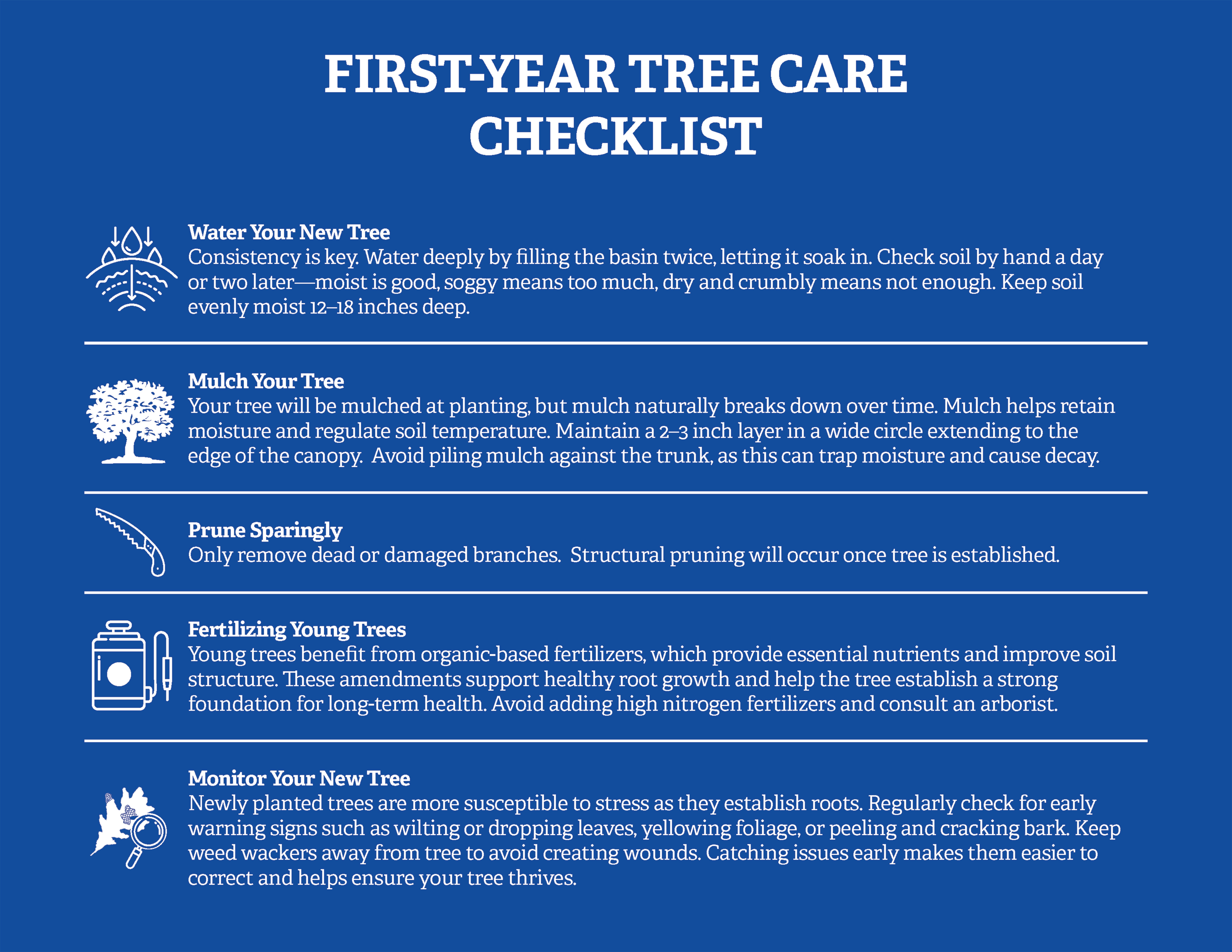How to Take Care of a Recently Planted Tree

Planting a new tree is an investment in your landscape and in the health of our community’s urban forest. But planting is only the beginning. The first year after planting is one of the most critical times for a tree’s long-term survival, and proper care can mean the difference between a thriving new member of your landscape and one that struggles, or even fails.
Here are the key steps we here at Texas Tree Surgeons recommend to ensure your tree establishes strong roots and gets off to a great start.


1. Watering: Consistent and Deep
Newly planted trees don’t yet have the established roots to gather enough water on their own. The first year is critical for helping them develop strong, deep roots. Your watering schedule should adjust with the seasons:
- First 4–5 Weeks: Water every 3–5 days to keep the soil around the root ball consistently moist but not soggy. This helps the tree settle in after planting.
- Spring & Fall: Shift to a deep soak once or twice per week, depending on rainfall. Cooler weather reduces stress, but trees are still actively growing roots.
- Summer: The toughest season for young trees. In hot Texas summers, you may need to water every other day, especially in sandy soils that dry out quickly. Clay soils hold more moisture, be sure to check regularly. Signs of stress include wilting leaves, browning edges, or early leaf drop.
- Winter: Even when dormant, trees need water. Provide a deep soak every 2–3 weeks if rainfall is lacking, with special attention to evergreens that continue losing moisture year-round.
Deep watering is critical. A long, slow soak allows water to penetrate the soil deeply, reaching the roots that will anchor the tree and support its growth for years to come. Shallow, frequent watering only wets the top layer of soil, which encourages weak, shallow roots that are more vulnerable to drought and wind.
Soaker hoses, drip irrigation, or letting a hose trickle at the base for 20–30 minutes are all good methods to achieve slow watering. On sandy soils, water may drain quickly and require more frequent soaking, while clay soils hold moisture longer but need even slower application to prevent runoff.
Rule of thumb: Give about 10–15 gallons per inch of trunk diameter per week, spread out over one or two deep soakings rather than daily splashes.

2. Mulching: Protect and Conserve
Applying a 2–3 inch layer of organic mulch around the base of your tree is one of the most effective ways to support its health in the first year. Mulch offers multiple benefits, including:
- Moisture retention: Mulch slows evaporation and keeps water available to the roots longer, reducing the need for frequent watering.
- Temperature regulation: It insulates the soil, keeping it cooler in the summer and warmer in the winter, protecting young, sensitive roots from stress.
- Weed suppression: Mulch creates a barrier that prevents weeds and grass from competing with your tree for water and nutrients.
- Soil improvement: As organic mulch breaks down, it enriches the soil with nutrients and improves its structure, creating a healthier growing environment for roots.
- Protection from mechanical damage: A mulch ring keeps lawnmowers, trimmers, and other equipment away from the trunk, reducing the risk of accidental injury.
When applying mulch, be sure to spread it in a wide circle that extends to the edge of the canopy (or anticipated canopy spread) and keep it a few inches away from direct contact with the trunk. Piling mulch against the trunk can trap moisture, leading to rot, decay, or pest issues.
3. Staking: Only if Necessary
Most young trees don’t need staking, but if your tree is in a windy area or has a weak trunk, temporary staking may help.
- Stakes should allow some natural movement, which encourages the trunk to strengthen.
- Remove stakes within 12 months to avoid girdling or damaging the tree.

4. Pruning: Less Is More
During the first year, your tree’s energy should be focused on root establishment—not on shaping its canopy. For this reason, pruning should be kept to a minimum. Only prune to address immediate concerns, such as:
- Broken or damaged branches
- Deadwood that could invite pests or disease
- Branches that create a safety hazard (e.g., low-hanging or obstructing visibility)
- Serious structural defects that could compromise the tree’s long-term health

5. Fertilization
Giving your newly planted tree the right start means ensuring it has access to the proper soil nutrients. Healthy soil fuels strong root development, sturdy trunks, and vigorous branch growth. While trees can survive without added fertilizer, young trees benefit greatly from a boost during their first year.
Applying an organic based fertilizer provides a steady supply of nutrients without overwhelming the roots. Organic fertilizers not only feed the tree but also improve soil structure and encourage beneficial microorganisms that support long-term growth.
Avoid heavy, fast-acting fertilizers, as they can burn tender roots or push out excessive top growth before the root system is ready to support it. The goal is to build a strong foundation below ground, setting your tree up for lasting health.

6. Monitor Your New Tree
Newly planted trees are more vulnerable to stress, and catching problems early can make the difference between a healthy tree and one that struggles. Make it a habit to check your tree regularly—weekly during the first year—for warning signs such as:
- Leaf changes: Wilting, yellowing, browning edges, or leaves dropping out of season often signal water issues (too much or too little).
- Branch dieback: Dead tips or branches that stop producing new growth may indicate root stress, pests, or disease.
- Fungal activity: Mushrooms or other fungal growth at the base of the tree can suggest root decay or excess moisture.
- Bark or trunk injury: Cracks, wounds, or peeling bark may open the door to pests and diseases.
- Slow or stunted growth: If your tree seems to stop growing or fails to put out new shoots, it may be lacking proper nutrients or water.
Catching these signs early gives you a chance to adjust watering, improve soil health, or bring in a certified arborist for a professional assessment. Proactive care during the first year sets your tree up for long-term success.

A tree’s first year is about roots before shoots. With thoughtful care, your tree will develop the strong foundation it needs to provide beauty, shade, and environmental benefits for decades to come.
At Texas Tree Surgeons, we’re here to help guide you through every stage—from planting to long-term care—so your trees stay healthy for life.
Tree Planting
We Love Trees

CUSTOMIZED PLANNING FOR YOUR LANDSCAPE
Prior to planting your new tree an arborist will work with you to find the best location on your property to optimize tree health and growth once installed. Depending on the size of the tree and how long ago the tree was removed from a spot will determine if that location can be used to replant.

PROPER WATERING TECHNIQUE
Before leaving we do one more final soaking once the tree has been planted. We will also leave a detailed care guide and a 5 gallon blue bucket with soaker holes to help you water your tree properly. Watering your tree with two buckets full every other day for the first two weeks will set your tree up for long-term growth.
Related Blogs
Similar blogs related to this topic


Holiday Gift Guide, Zodiac Signs as Trees
This holiday season a gift that keeps on giving in a time of over consumption is the most ethical and thoughtful gift. It is investment in a shared future that benefits their home and the…
Read more

Which Tree Should You Plant?
Tree selection needs to include a balance of preference in style with species selection that can thrive in North Texas unique soil conditions and climate. Below are some essential questions to ask yourself to ensure…
Read more

Benefits of Becoming a Tree City USA in Texas
In recent years, many Texas communities are exploring how to achieve Tree City USA. Tree cities reap numerous advantages, ranging from environmental to social benefits, enhancing the lives of their residents. What are the perks…
Read more








